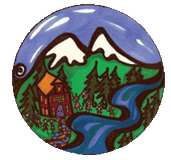The Wonder of Montessori Education
Cosmic Education at Maine Mountain Children's House
We had the pleasure of attending a “Cosmic Education” workshop through Maine Montessori Association put on by Joanne Alex and Elizabeth Hoffman. It reminded us of some of the most important and special parts of Montessori education. Maria Montessori developed a curriculum around the idea of Cosmic Education in the early 1940’s when the world was in the midst of the 2nd Great World War. As she observed children for many years, Dr. Montessori recognized that young children have a drive to understand their role within their world, even if their “world” still generally consisted of themselves, their family, and their classroom. She then created a learning environment that supported this need to belong and understand. Furthermore, Dr. Montessori knew that if we could provide a space during childhood for children to follow their natural tendencies, a place where kindness, curiosity, and inclusion was modeled by the adults, it would lead to a more peaceful child and, inevitably, a more peaceful adult. She was trying to support the idea of world peace from the ground up. Pretty genius, huh?
The actual Cosmic Education curriculum is taught to elementary age students through a series of stories called “great lessons”as a way to demonstrate the interconnection of all things and to help children learn more about that sense of wonder they have within themselves. The lessons are taught at an age when children are starting to understand that the world is so much bigger than themselves, which leads to wondering what his or her place is within the world and the universe.
The seeds of Cosmic Education are planted even earlier at the toddler and primary level. At this time, we emphasize two important things - the first being that there is an interdependence between children as individuals, our classroom environment, and our classroom community where we all rely on one another. The second part is that the child has an innate sense of wonder and amazement with the natural world and what exists beyond out planet and it is our job as teachers to create a space where we that amazement can be supported.
When we are creating a space for children to start to understand and take on his or her role in their classroom community, we provide opportunities for children to care for themselves, their classmates, and their school. This looks like putting lesson materials back where they belong, setting the table for others after eating, wiping up a spill they find on the floor - whether they are the source of the spill or not. This also looks like taking care of our plants, like E is doing in the picture. She’s using a plant mister and a cotton ball to gently wipe away dust on the plants leaves so it can absorb more energy from the sun.
“The Children's House, physically and philosophically, reflects Dr. Montessori’s belief that children are better prepared to be independent, confident, and responsible individuals through Cosmic Education. Montessori maintained that children learn best in an environment that encourages freedom of movement and discovery, and a space to develop an early understanding of their place as individuals in the universe.” (Lila S. Jokanovic, MFA. Where Do I Fit In? Cosmic Education and the Children's House, Montessori Life Spring 2013)
The second part of Cosmic Education that begins at the toddler and primary level is creating a space - both physically and intellectually - for a child to harness their inner sense of wonder. There are lessons that give children information about plants and animals that live both close and far away. Then, when things naturally come up, the child has the language to name and speak about what they are seeing. One day, last fall, one of the children discovered a chrysalis hanging from a balance beam in our yard. We all got down on our bellies and stared at the chrysalis (a monarch) and marveled at it’s gorgeous green color with tiny gold flecks. The children built a small stick wall around the beam to protect it from flying playground balls. We talked about the butterfly lifecycle, naming each stage and reading about the process in our classroom. We poured over books about butterflies and moths finding the ones we liked the best, and we named the parts of the butterfly and painted pictures of them. When we introduce scientific language to name and organize the natural things we share this planet with, and then we have conversations using that language as we wonder together about how simply beautiful and amazing it is, we are supporting the child’s intuitive knowledge that they are part of something really big that should be respected and cherished.
Dr. Montessori created such an incredible educational environment for young children. Her scientific mind and spiritual heart created a roadmap for adults to follow so we could see children build independence, confidence and a deep respect for all living things that we share this planet with. It was such a treat for Dani and I to spend our days amongst fellow Montessorians that have a true reverence for children and the Montessori method. If you want to incorporate more Cosmic Education into your family’s lives at home, here are some resources for you:
Nurturing the Spirit - Aline Wolf
Cosmic Wonder Series - I Know What Gravity Does, I Live in the Universe, I Travel on Planet Earth, I Look “Out” at the Stars - Aline Wolf
The Montessori Toddler - Simone Davies
To Educate the Human Potential - Maria Montessori
Education and Peace - Maria Montessori



